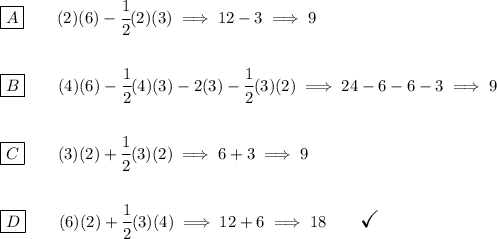Check the picture below.
the area of the region in white, is really the area of a trapezoid that has a height = 2, and bases of 3 and 6, so let's get its area
![\textit{area of a trapezoid}\\\\ A=\cfrac{h(a+b)}{2}~~ \begin{cases} h=height\\ a,b=\stackrel{parallel~sides}{bases}\\[-0.5em] \hrulefill\\ h=2\\ a=3\\ b=6 \end{cases}\implies A=\cfrac{2(3+6)}{2}\implies A=9](https://img.qammunity.org/2023/formulas/mathematics/middle-school/lcngunsup59jxhck4ckemydakmi218ipis.png)
now that we know the area in white, let's check all expressions, and whichever does NOT result in 9, is it.
